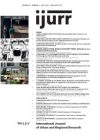Seeking to uncover a hidden side of Dubai, this article investigates the city’s ‘forgotten’ urban spaces. I use a theoretical framework that responds to a shift in global city research, emphasizing the everyday as well as transnational connections in which the local and the global are closely intertwined. I argue that such processes can be observed in these ‘forgotten’ settings, which, as well as being major gathering points, are utilized by Dubai’s low‐income migrant community for the exchange of information. Through an analysis of users and their activities as well as of the morphology of these spaces, I situate them within the overall development of Dubai. A key construct developed in this study and used as a unit of analysis is the notion of transitory sites — viewed as a major element in understanding migrant cities. The architectural and urban character of these sites is identified. A key finding is that low‐income migrants resist globalizing influences by claiming these settings and establishing linkages through them to their home countries.
Details
Written by:
YASSER ELSHESHTAWY
Digital Object Identifier (DOI)
10.1111/j.1468-2427.2008.00819.x
About DOI
Read full article as PDF
Read full article as HTML
See the references for this article
